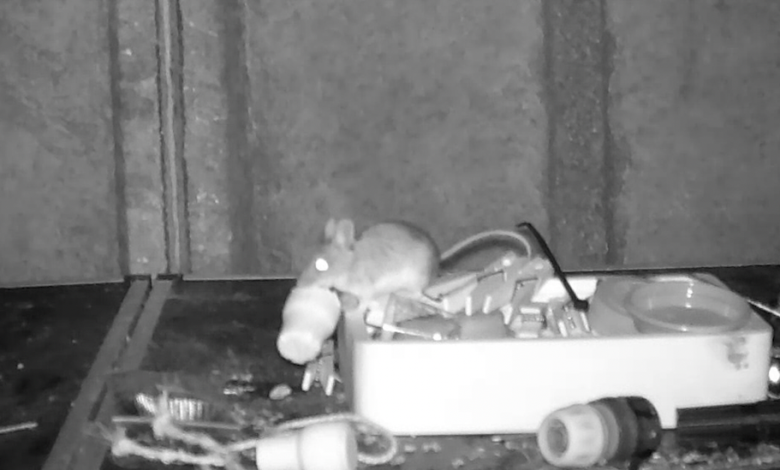‘Welsh Tidy Mouse’ Tidies Tiny Welsh House

There was something strange going on in Rodney Holbrook’s backyard shed.
For several months, someone — or something — had been apparently tidying up after the 75-year-old retiree. Every morning when he checked on his workbench, miscellaneous items had been cleared away and placed in a small box nearby.
At first, it was some bird food and nuts being moved around. Then, a few screws he had left out mysteriously appeared in the box.
Mr. Holbrook, a passionate wildlife photographer who lives near the town of Builth Wells in Wales, had his suspicions over the identity of the meticulous helper — it certainly wasn’t his wife. To investigate, he set up a night-vision camera and caught the mysterious visitor.
“Lo and behold, I got a video of the mouse,” he said. “Tidying up for me.”
In videos captured by Mr. Holbrook, a small mouse carries clothes pegs, cups and even cable ties to the box, with an enviable focus. A stick more than twice its length is no problem. A cork goes neatly into the pile, as do lids.
“I’m just awed by it, really,” Mr. Holbrook, a retired postal worker, said. “Every day I take it all back out again — and it’s all back in.”

The tidy mouse’s handiwork after a midnight cleanup.Credit…Animal News Agency
Mr. Holbrook has never actually seen the mouse scurrying about, though he has named it: “Welsh Tidy Mouse.” It’s not the first time he has encountered a “tidy mouse.” In 2019, Mr. Holbrook helped a friend near his hometown Bristol, England, capture footage of similar behavior from a mouse.
Of course, whether Welsh Tidy Mouse is intentionally decluttering is speculative. Mr. Holbrook believes the rodent may be trying to cover some nuts in the box to shield them from other rodents’ eyes.
That’s one possible explanation, according to Megan Jackson, a researcher at the University of Bristol who studies motivation using mice in labs. Another is that the mouse is building some kind of nest.
“We know that mice have a really strong drive to forage,” she said. Searching for interesting things in the environment to bring back and hoard, she said, is “intrinsically mouse-y behavior.”
In her research, Dr. Jackson said she had created a similar situation in which lab mice were encouraged to forage nesting material and carry it back to a box. “Mice are willing to put in a lot of effort to work at something they find rewarding,” she said.
Whatever its mission, Welsh Tidy Mouse is disciplined: The animal has rarely missed a night of reorganizing the workbench since Mr. Holbrook noticed the behavior in October. After it skipped one evening, it was back at it the next (perhaps it was a sick day?).
“I wish I had its motivation,” Dr. Jackson joked. “Mice are amazing, complex creatures. I think we can learn a lot from them.”
Since sharing his findings, Mr. Holbrook has been inundated with messages from those charmed by the Ratatouille-like deftness of the mouse in his shed. Some have suggested that Mr. Holbrook add some more entertaining objects for the mouse to organize — tiny furniture, for example.
“It’s brought a lot of joy to some people,” he said.
But Mr. Holbrook, who tries to get outdoors every day, is hesitant to change things up too much. “I just want it to be natural.” Other members of the household, like his wife, are happy to leave Welsh Tidy Mouse to its tiny house.
“She thinks it’s wonderful,” he said. “But she won’t go out in the shed. She’s afraid of mice.”
